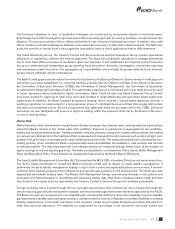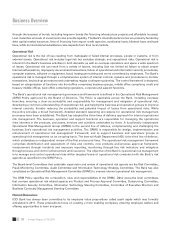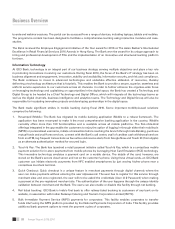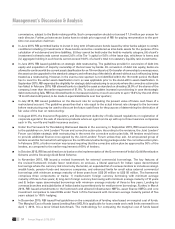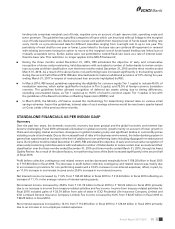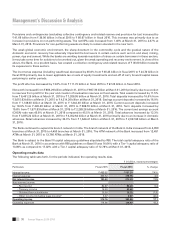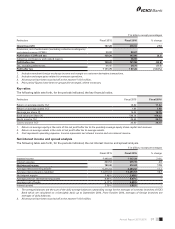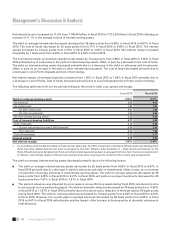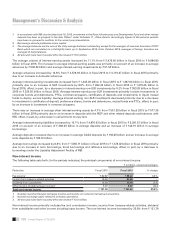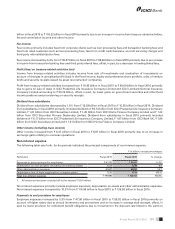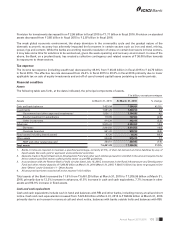ICICI Bank 2016 Annual Report Download - page 96
Download and view the complete annual report
Please find page 96 of the 2016 ICICI Bank annual report below. You can navigate through the pages in the report by either clicking on the pages listed below, or by using the keyword search tool below to find specific information within the annual report.
94
Management’s Discussion & Analysis
Annual Report 2015-2016
commission, subject to the Bank making prots. Such compensation should not exceed ` 1.0 million per annum for
each director. Further, private sector banks have to obtain prior approval of RBI for paying remuneration to the part-
time non-executive chairman;
In June 2015, RBI permitted banks to invest in long term infrastructure bonds issued by other banks subject to certain
conditions including (i) investments in these bonds cannot be considered as inter-bank assets for the purpose of the
calculation of net demand and time liabilities, (ii) they cannot be held under the held-to-maturity category, (iii) a bank’s
investment in these bonds cannot exceed 2.0% of its Tier 1 capital or 5.0% of the issue size, whichever is lower, and
(iv) aggregate holding in such bonds cannot exceed 10.0% of a bank’s total non-statutory liquidity ratio investments;
In June 2015, RBI issued guidelines on strategic debt restructuring. The guidelines provide for conversion of debt into
equity and acquisition of majority ownership of the borrower by banks. On conversion of debt into equity, banks are
allowed to continue with the current asset classication for an 18-month period. On transfer of ownership to a new sponsor,
the asset can be upgraded to the standard category and renancing of the debt is allowed without such renancing being
treated as a restructuring. However, in the event a new sponsor is not identied within the 18 month period, the Bank
has to revert to the earlier asset classication norm as was applicable prior to the stand-still in asset classication. In
September 2015, RBI expanded the eligibility for strategic debt restructuring to accounts where the corrective action plan
has failed. In February 2016, RBI allowed banks to classify the asset as standard on divesting 26.0% of the shares of the
company, lower than the earlier requirement of 51.0%. To avoid a sudden increase in provisioning in case the strategic
debt restructuring fails, RBI has directed banks to increase provisions on such accounts to up to 15.0% by the end of the
18 month stand-still period, to be made in equal installments over four quarters;
In July 2015, RBI issued guidelines on the discount rate for computing the present value of future cash ows of a
restructured account. The guideline prescribes that a rate equal to the actual interest rate charged to the borrower
before restructuring may be used to discount the future cash ows for the purpose of determining the diminution of
fair value of the loan on restructuring;
In August 2015, the Insurance Regulatory and Development Authority of India issued regulations on registration of
corporate agents for the sale of insurance products where an agent can tie up with up to three insurance companies
each in life, non-life and health insurance sectors;
Under the Framework for Revitalising Distressed Assets in the economy, in September 2015, RBI issued revisions
to the guidelines on Joint Lenders’ Forum and corrective action plan. According to the revisions, the Joint Lenders’
Forum can initiate strategic debt restructuring in the event the corrective action plan fails. All lenders would have
to provide additional nance once agreed by the Joint Lenders’ Forum unless they exit. An empowered group of
lenders would be formed which will approve the rectication/restructuring package under the corrective action plan.
In February 2016, a further revision was issued requiring that the corrective action plan be approved by 50% of the
lenders, as compared to the earlier requirement of 60% of lenders;
In October 2015, RBI issued directions to banks on the implementation of the Government of India’s Gold Monetisation
Scheme and the Sovereign Gold Bond Scheme;
In November 2015, RBI issued a revised framework for external commercial borrowings. The key features of
the revised framework include fewer restrictions on end-use, a liberal approach for Indian rupee denominated
borrowings where the currency risk is borne by the lender, an expanded list of overseas lenders to include sovereign
wealth funds, pension funds and insurance companies, and enhanced limits for small value external commercial
borrowings with minimum average maturity of three years from US$ 20 million to US$ 50 million. The framework
comprises three components or tracks: 1) medium-term foreign currency borrowing with minimum average
maturity of three to ve years; 2) long-term foreign currency borrowing with minimum average maturity of 10 years
and 3) Indian rupee denominated borrowings with minimum average maturity of three to ve years. Lending by
overseas branches and subsidiaries of Indian banks is permitted only for medium term borrowings. Further, in March
2016, RBI issued amendments to the framework and allowed infrastructure NBFCs, asset nance NBFCs and core
investment companies to raise ECBs under Track I of the framework with minimum average maturity period of ve
years subject to 100% hedging;
In December 2015, RBI issued nal guidelines on the computation of lending rates based on marginal cost of funds.
The Marginal Cost of funds based Lending Rate (MCLR) is applicable for loans made and credit limits renewed from
April 1, 2016. It is a tenor linked benchmark. The methodology for computing the marginal cost of funds based



